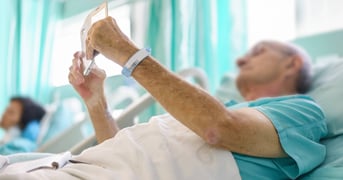Putting Patients First: How WiFi Can Help Reduce Patient Complaints in Healthcare
6 minute read | 04/06/2018

By 2019, it will be compulsory for all NHS Trusts to offer free WiFi to patients. Digitalisation is one of the ways healthcare can continue to put a patient’s experience first. It will also improve a Trust’s overall efficiency and reduce patient complaints by ensuring that their happiness is always the priority. Here’s how.
A digital patient survey found that 75 percent of patients expect digital services in healthcare, as long as these services meet their needs and expectations. This just shows how important it is for hospitals, GPs and health clinics to deliver WiFi to their patients.
WiFi can help reduce patient complaints by:
- Allowing Instant Access to Everything a Patient Might Want to Know
- Allowing Instant Data Transfer Which Boosts Efficiency Among Healthcare Staff
- Providing Insightful Analytics That Help with Resource Allocation
- Delivering Important Messages to Patients
- Improving the Patient Experience by Keeping Them Entertained and Connected to the Outside World
- Offering Easy Opportunities for Feedback
Allowing Instant Access to Everything a Patient Might Want to Know
Hospitals are such large places that when people arrive, they nearly always need staff assistance. Not only does this require staff to momentarily focus on these non-medical tasks, but it also means patients have to find someone who is free to help them and often, they have to queue because so many other people need assistance as well. This can be inconvenient for the patient or visitor.
Access to WiFi can help by providing the patient with all of the information they might need to know. Trusts can offer a Patient Engagement Platform, which contains an array of features such as wayfinding applications and the ability for patients to check into appointments and even order meals by themselves, all via the WiFi.
Signing into the WiFi can require patients to enter their contact details, so useful messages such as appointment reminders can be sent by email or text message if the user agrees. These features allow patients to do many of the activities they originally needed staff for, which allows the hospital team to focus on their other vital, medical-related tasks.
Providing Insightful Analytics That Help with Resource Allocation
WiFi can provide more than just a connection to the internet. Trusts can also access insightful analytics into how many people come to the hospital at what time, what they’re there for and how long they stay. Ultimately, this can reveal when the busiest times at the hospital are, which can help management allocate resources more intuitively.
For example, the hospital’s facilities managers who can then plan shift rotas more effectively. They can use these analytics to predict when, for example, cafes or concessions will need the highest or lowest number of staff on rotation.
This ensures they always have the right amount of employees working, which boosts a productive working environment and minimises the likelihood of patients and visitors queuing or being unacknowledged by staff for long periods of time. If they can be served more quickly, their satisfaction will rise.
Delivering Important Messages to Patients
Once patients have connected to the WiFi and access the PEP, targeted health promotion messages can be directly shown to them while they’re on site. From vaccinations to patient-specific check up reminders, these targeted messages appear as banners within the PEP that are a lot harder to ignore than letters sent in the post or posters on walls.
These messages can be sent while the patients are at the hospital, which can remind them to book in those prevention appointments before they forget and leave the site.
By promoting and encouraging people to try and prevent illnesses rather than seek a cure, potential conditions can be caught before it’s too late. Several conditions can be easily prevented and managed much more easily if they’re identified much earlier on. This can boost the overall efficiency of the NHS Trust and help improve patient satisfaction.
Improving the Patient Experience by Keeping Them Entertained and Connected to the Outside World
Many patients can feel as though they are “hostages” to their health condition as they are resigned to spending days, weeks or even longer in their wards. This can affect their families too, as they have to balance their work and social life with designated visiting hours.
And it doesn’t help that hospitals can be lonely, intimidating places with no cellular signal. This can lead to patients feeling extremely isolated as they can’t message loved ones on the outside in the same way they would from home.
Often, WiFi is the only way patients can stay connected to the outside world, whether it’s by instant message chats, video calls or emails to their family and friends. This can be a lifeline for some people, especially sick children, and help to make their journey to recovery feel much more pleasant.
For example, in December 2014, patients at Noah’s Ark Children’s Hospital in Cardiff, Wales were able to chat face-to-face with Santa via tablets - thanks to hospital WiFi. This helped to boost spirits of the patients tremendously and made a positive difference to their experience at the hospital.
It’s not just the communication door that WiFi opens. WiFi also allows patients and visitors instant access to the world of entertainment - right from their own device. From streaming services like Netflix and online shopping to mobile-friendly games and the hospital radio, these features keep both children and adults distracted and amused. This too helps to improve the patient experience.
Offering Easy Opportunities for Feedback
It’s important for Trusts to hear what patients and visitors thought of their healthcare service. But it’s easy for people to forget or ignore surveys sent via email or in the post. WiFi in hospitals, GPs and clinics encourage people to participate in these surveys while they’re on site and before they forget about the details of their experience.
Feedback tools, such as the Friends and Family Test, can be taken directly on patients’ mobile phones once they access the WiFi portal. And again, the banners in the PEP can remind them to take the survey before they leave.
Being able to gather feedback is the only way Trusts will be able to know which areas are working and which need more improvement. And this can help to reduce patient complaints in the long run.
Where to Find Out More About What WiFi Can Bring to Healthcare
The priority of the healthcare industry has always been to provide the most excellent quality of care and improving patient experience is one of the cornerstones for that goal. WiFi can be key because of the values it brings - from boosting patient morale by keeping them entertained and connected to the outside world to improving efficiency among healthcare teams. WiFi certainly isn’t something NHS organisations can ignore.
To find out more about bespoke digital patient engagement solutions and what they can bring to the healthcare service, download a copy of our Healthcare Case Study.
About the author
Rebecca O'Donovan
Becky is the Marketing Director at SPARK TSL, of whom she has worked for since 2012. She is responsible for high-level marketing strategy focusing on lead generation and aiding the vision of the business to ensure business growth.
More articles by the author
Related articles
 Healthcare Industry
Healthcare Industry
15 Healthcare Statistics That Show Technology is Vital For the NHS
Healthcare is one of the most important facets of society we frequently rely on. The pressure the NHS faces ...
 Healthcare Industry
Healthcare Industry
Why Should Healthcare be WiFi enabled? | SPARK TSL
It’s a secure, stable and consistent service that allows the public to browse the internet and download apps. ...
 Patient Experience
Patient Experience
How Improving Patient Experience Can Save the NHS Money
Improving patient experience is one of the most efficient ways to reduce NHS costs. Whether it’s combatting ...


